VCQ RESEARCH
Our research explores various aspects of quantum science from a theoretical and experimental standpoint.
From foundational aspects of quantum mechanics to quantum aspects of spacetime, via quantum information, quantum sensing and devices, quantum optics, hybrid and many-body quantum systems, our researcher work at the forefront of their research field.
Foundational Aspects of Quantum Mechanics
The field of Quantum Foundations explores the most counterintuitive insights given by the fundamental questions in quantum physics, with the ambition to better comprehend the theory, to reformulate it, and to propose generalizations that will be relevant for the understanding of our world. Indeed, many of the fundamental questions that were posed in the 1920’s when quantum mechanics was laid down, are yet to be answered. The pursuit of these answers has in time opened up a large variety of surprising paths, from quantum communication and computing to quantum sensing, and will be of paramount importance both for its applications and for combining it with other physical theories like General Relativity.
Quantum Many-Body Systems & Themodynamics
This field focuses on understanding how quantum systems interact with each other. Engineering and exploiting complex many-body quantum systems for quantum information purposes pose some of the most outstanding challenges in quantum physics. Such arrays can serve as versatile model systems for condensed matter physics, or as useful quantum information processors and effective setups for precision atomic and molecular physics measurements. In another perspective, shrinking technology is leading to an extension of thermodynamics to the quantum realm, where notions like temperature and work lose their usual meanings, and the classical laws do not necessarily apply. The focus of the field is, on the one hand, designing more efficient quantum machines and on the other, describing the spread of information through quantum systems.
Quantum Aspects of Spacetime
This research direction explores the relation between quantum theory and spacetime physics. Exploring how quantum phenomena like Bell correlations, interference or superposition fit into spacetime and connect with gravity reveals fascinating and useful insights into both. Questions that we study include: what if the causal structure of spacetime is in a superposition? What happens if not only our particles, but also our reference frames are quantum systems? Can we use the structure of spacetime for novel quantum information-theoretic protocols or to derive parts of quantum theory? An ultimate goal of this research is also to obtain new insights into the old problem of quantum gravity. To this end, we pursue optomechanical experiments that aim to approach the quantum regime of gravity.
Hybrid Quantum Systems
Platforms for information processing, secure communication and high-precision sensing are being implemented with diverse physical systems, ranging from photons, nanomechanical structures, atoms and spins, to mesoscopic superconducting, each with particular strengths and weaknesses. For example, photons, which scarcely interact with matter, are ideal candidates for transmitting quantum information over long distances; superconducting circuits can process information encoded in their quantum states very rapidly; atom spins can be used as long-living quantum memories. A hybrid quantum system proposes to develop devices that interface different physical components with complementary functionalities, that will be simultaneously efficient in reliably storing, processing, and transmitting quantum information
Quantum Optics
The field of quantum optics focuses on applying quantum and semi-classical mechanics to photons or light to investigate phenomena involving light and its interaction with matter at the level of atoms and molecules. It deals with processes where the quantum states of the electromagnetic field are of central relevance. This includes studying the particle-like properties of photons. Photons have been used to test many of the counter-intuitive predictions of quantum mechanics, such as entanglement and teleportation, and are a useful resource for quantum information processing. In recent years, miniaturization of optical elements, sources and detectors have allowed a full integration of very complex optical circuits in tunable photonic chips. Today, quantum optics is used, among others, to control individual quantum systems such as atoms, to encode and propagate information stored in the degrees of freedom of photons, and to perform controlled simulations of complex quantum systems.
Quantum Sensing and Devices
The ability to precisely measure physical quantities is an ultimate limit in our knowledge of the world and our technological progress. When considering a quantum system, the act of measurement itself modifies the state, thus providing a bound on the achievable precision. On the other hand, exploiting quantum properties of single particles, measurement capability can be pushed far beyond what has previously been possible. Since a quantum state is so easily disturbed, this means that they also have the potential to become extraordinarily sensitive measuring instruments. This field aims to build quantum sensors that achieve the best precision that is allowed by the laws of physics, with an additional focus on making them inexpensive and commercially attractive.
Quantum Information, Computing and Communication
This research field aims to exploit quantum-mechanical phenomena to encode, transmit, manipulate and decode information. Each of these processes takes advantage of underlying quantum principles such as superposition and entanglement and provide a significant advantage over their classical counterpart. Quantum computing promises to solve certain computational problems (for example, integer factorization) substantially faster than by using classical computers. Quantum communication is a field of applied quantum physics closely related to quantum information processing and quantum teleportation: one of the most interesting applications is protecting information channels against eavesdropping by means of quantum cryptography. The most well-known and developed application of quantum cryptography is quantum key distribution, where the presence of an eavesdropper is revealed by the imperfect correlation between the two lists of bits obtained after the transmission of qubits between the emitter and the receiver.
